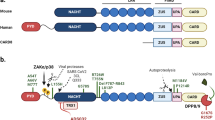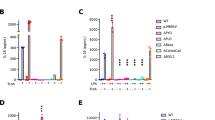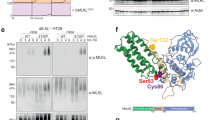Abstract
Formyl-Met-Leu-Phe (fMLP) is a potent chemoattractant molecule released from both bacteria and damaged mitochondria that activates fMLP receptors (FPR) leading to neutrophil chemotaxis, degranulation and superoxide production. A common missense single nucleotide polymorphism in the human FPR1 gene at nucleotide c.32C>T results in the amino-acid substitution, p.I11T, in the FPR1 extracellular amino-terminus. The minor (c.32T) allele frequencies were 0.25, 0.27, 0.25, 0.15 and 0.14 in healthy Caucasian, African, East Indian, Chinese and Native Canadian individuals, respectively. In subjects homozygous for the p.T11 allele, we find elevated serum concentrations of C-reactive protein, increased absolute counts of blood leukocytes and neutrophils, and erythrocyte sedimentation rates. When expressed in HEK 293 and RBL-2H3 cells a substantial proportion of FPR1 p.I11T variant is retained intracellularly and agonist-independent internalization of the FPR1 p.I11T variant, but not the wild-type FPR1, is constitutively associated with β-arrestin2-GFP in vesicles. Moreover, basal N-acetyl-D-glucosaminidase release is increased in primary neutrophils isolated from subjects either heterozygous or homozygous for the FPR1 p.T11 allele. Taken together, the data suggest an increased receptor activity and phenotypic expression of increased inflammatory indices in subjects with the p.T11 allele.
This is a preview of subscription content, access via your institution
Access options
Subscribe to this journal
Receive 6 print issues and online access
$259.00 per year
only $43.17 per issue
Buy this article
- Purchase on Springer Link
- Instant access to full article PDF
Prices may be subject to local taxes which are calculated during checkout




Similar content being viewed by others
Abbreviations
- CRP:
-
C reactive protein
- ESR:
-
erythrocyte sedimentation rate
- fMLP:
-
formyl-Met-Leu-Phe
- FPR1:
-
formyl peptide receptor
- GFP:
-
green fluorescent protein
- GPCR:
-
G protein-coupled receptor
- HEK 293:
-
human embryonic kidney cells
- PMA:
-
phorbol myristate acetate⁁RBL-2H3⁁rat basophilic leukemia cells
- SNP:
-
single nucleotide polymorphism
References
Sandborg R, Smolen J . Early biochemical events in leukocyte activation. Lab Invest 1988; 59: 300–320.
Schiffmann E, Corcoran BA, Wahl SM . N-formylmethionyl peptides as chemoattractants for leucocytes. Proc Natl Acad Sci USA 1975; 72: 1059–1062.
Le Y, Murphy PM, Wang JM . Formyl-peptide receptors revisited. Trends Immunol 2002; 23: 541–548.
Haslett C, Savill JS, Meagher L . The neutrophil. Curr Opin Immunol 1989; 2: 10–18.
Ye RD, Cavanagh SL, Quehenberger O, Prossnitz ER, Cochrane CG . Isolation of a cDNA that encodes a novel granulocyte N-formyl peptide receptor. Biochem Biophys Res Commun 1992; 184: 582–589.
Murphy PM . The molecular biology of leukocyte chemoattractant receptors. Annu Rev Immunol 1994; 12: 593–633.
Prossnitz ER, Ye RD . The N-formyl peptide receptor: a model for the study of chemoattractant receptor structure and function. Pharmacol Ther 1997; 74: 73–102.
Gao JL, Lee EJ, Murphy PM . Impaired antibacterial host defense in mice lacking the N-formylpeptide receptor. J Exp Med 1999; 189: 657–662.
Hartt JK, Barish G, Murphy PM, Gao JL . N-formylpeptides induce two distinct concentration optima for mouse neutrophil chemotaxis by differential interaction with two N-formylpeptide receptor (FPR) subtypes. Molecular characterization of FPR2, a second mouse neutrophil FPR. J Exp Med 1999; 190: 741–747.
Sahagun-Ruiz A, Colla JS, Juhn J, Gao JL, Murphy PM, McDermott DH . Contrasting evolution of the human leukocyte N-formylpeptide receptor subtypes FPR and FPRL1R. Genes Immun 2001; 2: 335–342.
Gwinn MR, Sharma A, De Nardin E . Single nucleotide polymorphisms of the N-formyl peptide receptor in localized juvenile periodontitis. J Periodontol 1999; 70: 1194–1201.
Jones BE, Miettinen HM, Jesaitis AJ, Mills JS . Mutations of F110 and C126 of the formyl peptide receptor interfere with G-protein coupling and chemotaxis. J Periodontol 2003; 74: 475–484.
Bhattacharya M, Anborgh PH, Babwah AV, Dale L, Dobransky T, Benovic JL et al. Arrestins regulate a Ral-GDS-Ral effector pathway that mediates cytoskeletal reorganization. Nat Cell Biol 2002; 4: 547–555.
Graham TE, Prossnitz ER, Dorin RI . Dexras1/AGS-1 inhibits signal transduction from the Gi-coupled formyl peptide receptor to Erk-1/2 MAP kinases. J Biol Chem 2002; 277: 10876–10882.
Tarasova NI, Stauber RH, Choi JK, Hudson EA, Czerwinski G, Miller JL et al. Visualization of G protein-coupled receptor trafficking with the aid of the green fluorescent protein. Endocytosis and recycling of cholecystokinin receptor type A. J Biol Chem 272; 1997: 14817–14824.
Shapiro MJ, Coughlin SR . Separate signals for agonist-independent and agonist-triggered trafficking of protease-activated receptor 1. J Biol Chem 1998; 273: 29009–29014.
Anborgh PH, Dale L, Seachrist J, Ferguson SSG . Differential regulation of β2-adrenergic and angiotensin II type 1A receptor trafficking and resensitization: Role of carboxyl-terminal domains. Mol Endocrino 2000; 14: 2040–2053.
Dale LB, Bhattacharya M, Seachrist JL, Anborgh PH, Ferguson SSG . Agonist-dependent and -independent internalization of metabotropic glutamate receptor 1a: β-Arrestin isoform-specific endocytosis. Mol Pharmacol 2001; 60: 1243–1253.
Fourgeaud L, Bessis AS, Rossignol F, Pin JP, Olivo-Marin JC, Hemar A . The metabotropic glutamate receptor mGluR5 is endocytosed by a clathrin-independent pathway. J Biol Chem 2003; 278: 12222–12230.
Xia S, Kjaer S, Zheng K, Hu PS, Xu T, Hokfelt T, Xu ZQ . Constitutive and ligand-induced internalization of EGFP-tagged galanin R2 and Rl receptors in PC12 cells. Neuropeptides 2005; 39: 173–178.
Koch T, Wu DF, Yang LQ, Brandenburg LO, Hollt V . Role of phospholipase D2 in the agonist-induced and constitutive endocytosis of G-protein coupled receptors. J Neurochem 2006; 97: 365–372.
Belisle B, Abo A . N-Formyl peptide receptor ligation induces rac-dependent actin reorganization through Gβγ subunits and class Ia phosphoinositide 3-kinases. J Biol Chem 2000; 275: 26225–26232.
Nagaji J . The role of protein kinase C and [Ca2+]i in superoxide anion synthesis and myeloperoxidase degranulation of human neutrophils. Kurume Med J 1999; 46: 157–162.
Zhang Y, Syed R, Uygar C, Pallos D, Gorry MC, Firatli E et al. Evaluation of human leukocyte N-formylpeptide receptor (FPR1) SNPs in aggressive periodontitis patients. Genes Immun 2003; 4: 22–29.
Kushwaha N, Harwood SC, Wilson AM, Berger M, Tecott LH, Roth BL, Albert PR . Molecular determinants in the second intracellular loop of the 5-hydroxytryptamine-1A receptor for G-protein coupling. Mol Pharmacol 2006; 69: 1518–1526.
Oakley RH, Laporte SA, Holt JA, Barak LS, Caron MG . Association of β-arrestin with G protein-coupled receptors during clathrin-mediated endocytosis dictates the profile of receptor resensitization. J Biol Chem 1999; 274: 32248–32257.
Barak LS, Oakley RH, Laporte SA, Caron MG . Constitutive arrestin-mediated desensitization of a human vasopressin receptor mutant associated with nephrogenic diabetes insipidus. Proc Natl Acad Sci USA 2001; 98: 93–98.
Barlic J, Andrews JD, Kelvin AA, Bosinger S, DeVries ME, Xu L et al. Regulation of tyrosine kinase activation and granule release through beta-arrestin by CXCRI. Nat Immunol 2000; 1: 227–233.
Ridker PM, Cannon CP, Morrow D, Rifai N, Rose LM, McCabe CH et al. Pravastatin or Atorvastatin evaluation and infection therapy-thrombolysis in myocardial infarction 22 (PROVE IT-TIMI 22) investigators. C-reactive protein levels and outcomes after statin therapy. N Engl J Med 2005; 352: 20–28.
Hegele RA, Ban MR, Young TK . Serum C-reactive protein in Canadian Inuit and its association with genetic variation on chromosome 1q21. Clin Chem 2001; 47: 1707–1709.
Suk HJ, Ridker PM, Cook NR, Zee RY . Relation of polymorphism within the C-reactive protein gene and plasma CRP levels. Atherosclerosis 2005; 178: 139–145.
Abernathy VJ, Webster RO, Dahms TE . C-reactive protein inhibits increased pulmonary vascular permeability induced by fMLP in isolated rabbit lungs. Am J Physiol 1996; 271: H507–H513.
Mortensen RF, Zhong W . Regulation of phagocytic leukocyte activities by C-reactive protein. J Leukoc Biol 2000; 67: 495–500.
Zhong W, Zen Q, Tebo J, Schlottmann K, Coggeshall M, Mortensen RF . Effect of human C-reactive protein on chemokine and chemotactic factor-induced neutrophil chemotaxis and signaling. J Immunol 1998; 161: 2533–2540.
Heuertz RM, Tricomi SM, Ezekiel UR, Webster RO . C-reactive protein inhibits chemotactic peptide-induced p38 mitogen-activated protein kinase activity and human neutrophil movement. J Biol Chem 1999; 274: 17968–17974.
Heuertz RM, Schneider GP, Potempa LA, Webster RO . Native and modified C-reactive protein bind different receptors on human neutrophils. Int J Biochem Cell Biol 2005; 37: 320–335.
Szalai AJ, Weaver CT, McCrory MA, van Ginkel FW, Reiman RM, Kearney JF et al. Delayed lupus onset in (NZB × NZW)F1 mice expressing a human C-reactive protein transgene. Arthritis Rheum 2003; 48: 1602–1611.
Zhang J, Ferguson SSG, Barak LS, Menard L, Caron MG . Dynamin and beta-arrestin reveal distinct mechanisms for G protein-coupled receptor internalization. J Biol Chem 1996; 271: 18302–18305.
Boyum A . Isolation of mononuclear cells and granulocytes from human blood. Scad J Clin Lab Invest 1968; 21: 77–79.
Wright DG, Gallin J . Secretory responses of human neutrophils: exocytosis of specific (secondary) granules by human neutrophils during adherence in vitro and during exudation in vivo. J Immunol 1979; 123: 285–294.
Sklar LA, Oades ZG, Jesaitis AJ, Painter RG, Cochrane CG . Fluoresceinated chemotactic peptide and high-affinity antifluorescein antibody as a probe of the temporal characteristics of neutrophil stimulation. Proc Natl Acad Sci USA 1981; 78: 7540–7544.
Weidema AF, Dixon SJ, Sims SM . Activation of P2Y but not P2X4 nucleotide receptors causes elevation of [Ca2+]i in mammalian osteoclasts. Am J Physiol Cell Physiol 2001; 280: C1531–C1539.
Acknowledgements
SSGF and RAH hold Canada Research Chairs and are Career Investigators of the Heart and Stroke Foundation of Ontario. This work was supported by HSFO Grants T-4987 and T-5933 to SSGF, HSFO Grant T-4772 to RAH and CIHR Grant MOP 43959 to RDF.
Author information
Authors and Affiliations
Corresponding author
Rights and permissions
About this article
Cite this article
Bhattacharya, M., Wang, J., Ribeiro, F. et al. Analysis of a missense variant of the human N-formyl peptide receptor that is associated with agonist-independent β-arrestin association and indices of inflammation. Pharmacogenomics J 7, 190–199 (2007). https://doi.org/10.1038/sj.tpj.6500416
Received:
Revised:
Accepted:
Published:
Issue Date:
DOI: https://doi.org/10.1038/sj.tpj.6500416



